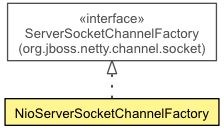
- java.lang.Object
-
- org.jboss.netty.channel.socket.nio.NioServerSocketChannelFactory
-
- All Implemented Interfaces:
- ChannelFactory, ServerChannelFactory, ServerSocketChannelFactory, ExternalResourceReleasable
public class NioServerSocketChannelFactory extends Object implements ServerSocketChannelFactory
AServerSocketChannelFactorywhich creates a server-side NIO-basedServerSocketChannel. It utilizes the non-blocking I/O mode which was introduced with NIO to serve many number of concurrent connections efficiently.How threads work
There are two types of threads in a
NioServerSocketChannelFactory; one is boss thread and the other is worker thread.Boss threads
Each bound
ServerSocketChannelhas its own boss thread. For example, if you opened two server ports such as 80 and 443, you will have two boss threads. A boss thread accepts incoming connections until the port is unbound. Once a connection is accepted successfully, the boss thread passes the acceptedChannelto one of the worker threads that theNioServerSocketChannelFactorymanages.Worker threads
One
NioServerSocketChannelFactorycan have one or more worker threads. A worker thread performs non-blocking read and write for one or moreChannels in a non-blocking mode.Life cycle of threads and graceful shutdown
All threads are acquired from the
Executors which were specified when aNioServerSocketChannelFactorywas created. Boss threads are acquired from thebossExecutor, and worker threads are acquired from theworkerExecutor. Therefore, you should make sure the specifiedExecutors are able to lend the sufficient number of threads. It is the best bet to specify a cached thread pool.Both boss and worker threads are acquired lazily, and then released when there's nothing left to process. All the related resources such as
Selectorare also released when the boss and worker threads are released. Therefore, to shut down a service gracefully, you should do the following:- unbind all channels created by the factory,
- close all child channels accepted by the unbound channels, and
(these two steps so far is usually done using
ChannelGroup.close()) - call
releaseExternalResources().
RejectedExecutionExceptionand the related resources might not be released properly.
-
-
Constructor Summary
Constructors Constructor and Description NioServerSocketChannelFactory()Create a newNioServerSocketChannelFactoryusingExecutors.newCachedThreadPool()for the boss and worker.NioServerSocketChannelFactory(BossPool<NioServerBoss> bossPool, WorkerPool<NioWorker> workerPool)Create a new instance.NioServerSocketChannelFactory(Executor bossExecutor, Executor workerExecutor)Creates a new instance.NioServerSocketChannelFactory(Executor bossExecutor, Executor workerExecutor, int workerCount)Creates a new instance.NioServerSocketChannelFactory(Executor bossExecutor, int bossCount, Executor workerExecutor, int workerCount)Create a new instance.NioServerSocketChannelFactory(Executor bossExecutor, int bossCount, WorkerPool<NioWorker> workerPool)Create a new instance.NioServerSocketChannelFactory(Executor bossExecutor, WorkerPool<NioWorker> workerPool)Creates a new instance.
-
Method Summary
Methods Modifier and Type Method and Description ServerSocketChannelnewChannel(ChannelPipeline pipeline)voidreleaseExternalResources()Releases the external resources that this factory depends on to function.voidshutdown()Shudown the ChannelFactory and all the resource it created internal.
-
-
-
Constructor Detail
-
NioServerSocketChannelFactory
public NioServerSocketChannelFactory()
Create a newNioServerSocketChannelFactoryusingExecutors.newCachedThreadPool()for the boss and worker. SeeNioServerSocketChannelFactory(Executor, Executor)
-
NioServerSocketChannelFactory
public NioServerSocketChannelFactory(Executor bossExecutor, Executor workerExecutor)
Creates a new instance. Calling this constructor is same with callingNioServerSocketChannelFactory(Executor, Executor, int)with the worker executor passed intogetMaxThreads(Executor).
-
NioServerSocketChannelFactory
public NioServerSocketChannelFactory(Executor bossExecutor, Executor workerExecutor, int workerCount)
Creates a new instance.
-
NioServerSocketChannelFactory
public NioServerSocketChannelFactory(Executor bossExecutor, int bossCount, Executor workerExecutor, int workerCount)
Create a new instance.
-
NioServerSocketChannelFactory
public NioServerSocketChannelFactory(Executor bossExecutor, WorkerPool<NioWorker> workerPool)
Creates a new instance.- Parameters:
bossExecutor- theExecutorwhich will execute the boss threadsworkerPool- theWorkerPoolwhich will be used to obtain theNioWorkerthat execute the I/O worker threads
-
NioServerSocketChannelFactory
public NioServerSocketChannelFactory(Executor bossExecutor, int bossCount, WorkerPool<NioWorker> workerPool)
Create a new instance.- Parameters:
bossExecutor- theExecutorwhich will execute the boss threadsbossCount- the number of boss threadsworkerPool- theWorkerPoolwhich will be used to obtain theNioWorkerthat execute the I/O worker threads
-
NioServerSocketChannelFactory
public NioServerSocketChannelFactory(BossPool<NioServerBoss> bossPool, WorkerPool<NioWorker> workerPool)
Create a new instance.- Parameters:
bossPool- theBossPoolwhich will be used to obtain theNioServerBossthat execute the I/O for accept new connectionsworkerPool- theWorkerPoolwhich will be used to obtain theNioWorkerthat execute the I/O worker threads
-
-
Method Detail
-
newChannel
public ServerSocketChannel newChannel(ChannelPipeline pipeline)
Description copied from interface:ChannelFactory- Specified by:
newChannelin interfaceChannelFactory- Specified by:
newChannelin interfaceServerChannelFactory- Specified by:
newChannelin interfaceServerSocketChannelFactory- Parameters:
pipeline- theChannelPipelinewhich is going to be attached to the newChannel- Returns:
- the newly open channel
-
shutdown
public void shutdown()
Description copied from interface:ChannelFactoryShudown the ChannelFactory and all the resource it created internal.- Specified by:
shutdownin interfaceChannelFactory
-
releaseExternalResources
public void releaseExternalResources()
Description copied from interface:ChannelFactoryReleases the external resources that this factory depends on to function. An external resource is a resource that this factory didn't create by itself. For example,Executors that you specified in the factory constructor are external resources. You can call this method to release all external resources conveniently when the resources are not used by this factory or any other part of your application. An unexpected behavior will be resulted in if the resources are released when there's an open channel which is managed by this factory. This will also callChannelFactory.shutdown()before do any action- Specified by:
releaseExternalResourcesin interfaceChannelFactory- Specified by:
releaseExternalResourcesin interfaceExternalResourceReleasable
-
-